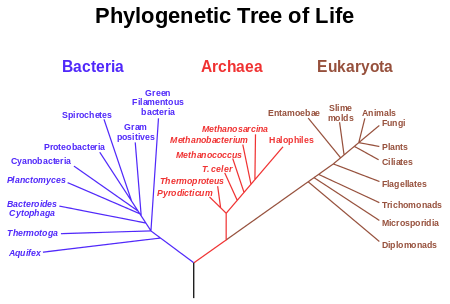Lineage (evolution)
An evolutionary lineage is a temporal series of organisms, populations, cells, or genes connected by a continuous line of descent from ancestor to descendent.[1][2] Lineages are subsets of the evolutionary tree of life. Lineages are often determined by the techniques of molecular systematics.
Phylogenetic representation of lineages

Lineages are typically visualized as subsets of a phylogenetic tree. For example, the tree in Figure 1 shows the separation of life into three ancient clades: bacteria, archaea, and eukaryotes. A lineage is a single line of descent or linear chain within the tree, while a clade is a (usually branched) monophyletic group, containing a single ancestor and all its descendants. Phylogenetic trees are typically created from DNA, RNA or protein sequence data. Apart from this, morphological differences and similarities have been, and still are used to create phylogenetic trees. Sequences from different individuals are collected and their similarity is quantified. Mathematical procedures are used to cluster individuals by similarity.
Just as a map is a scaled approximation of true geography, a phylogenetic tree is an approximation of the true complete evolutionary relationships. For example, in Figure 1, the entire clade of animals has been collapsed to a single branch of the tree. However, this is merely a limitation of rendering space. In theory, a true and complete tree for all living organisms or for any DNA sequence could be generated.
References
- ↑ The University of California, Berkeley resource on understanding evolution defines a lineage as "A continuous line of descent; a series of organisms, populations, cells, or genes connected by ancestor/descendent relationships." Understanding Evolution, Glossary of Terms
- ↑ The Oxford English Dictionary defines biological lineage as "a sequence of species each of which is considered to have evolved from its predecessor."OED definition of lineage